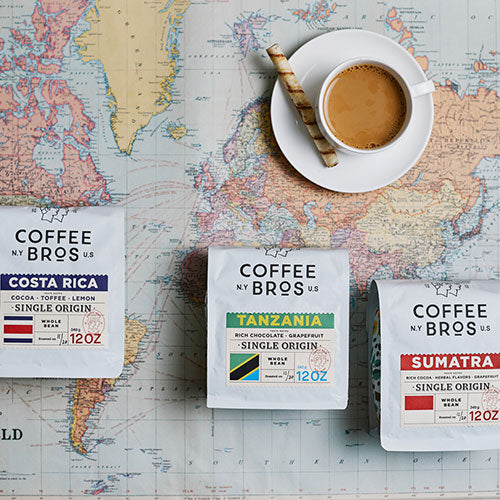Checking Out the Abundant Tastes of Coffee Beans: a Deep Study Espresso and Blended Coffee Beans
When you explore the rich tastes of coffee beans, you reveal an intricate globe where each range brings its own personality to your cup. Understanding the beginnings, refining techniques, and roasting strategies can change your coffee experience. As you navigate through the art of espresso and the creative thinking behind combined coffees, you'll begin to appreciate the nuances that make each sip one-of-a-kind. What you'll find following may change the means you enjoy your morning mixture.
The Beginnings of Coffee Beans: Checking Out Terroir and Taste Profiles
When you take a sip of coffee, you're not simply taking pleasure in a drink; you're experiencing an abundant tapestry of flavors formed by the beans' beginnings. Each region generates distinct taste accounts affected by environment, soil, and elevation. As an example, beans from Ethiopia typically break with brilliant, fruity notes, while those from Colombia have a tendency to supply a balanced, nutty sweet taste.
As you explore various beginnings, you'll discover just how terroir-- the environmental aspects influencing a crop-- plays a crucial duty - Single Origin Espresso. The same coffee range can taste significantly different relying on where it's expanded
When you consider these aspects, you start to appreciate the intricacy behind your mug. Each sip narrates of the land and the farmers that nurtured the beans. So, next time you indulge, assume about the journey your coffee took prior to it reached your hands, and enjoy those complex tastes that mirror its origin.
Recognizing Coffee: The Art and Scientific Research Behind the Mixture
When you think of coffee, it's not practically the strong flavor; it's also about the strategies that bring it to life. Recognizing just how various prep work techniques impact taste can change your developing experience. Let's explore the complexities of espresso preparation and reveal the unique flavor accounts that make each cup special.
Espresso Prep Work Methods
Espresso preparation is both a scientific research and an art, integrating accurate techniques with a deep understanding of coffee. To begin, you'll wish to choose top notch, newly baked beans and grind them carefully for optimal extraction (Single Origin Espresso). The work size is vital; also rugged, and your coffee will be weak, too great, and it'll be bitter
Next, tamp the grounds uniformly in the portafilter to ensure consistent extraction. When you secure it into the equipment, goal for a brewing temperature level between 190 ° F and 205 °
F.As you pull the shot, expect the best extraction time-- around 25-30 secs. The result should be an abundant, creamy espresso with a stunning layer of crema on top. With technique, you'll master these strategies.
Flavor Profiles Explained
The globe of coffee offers a rich tapestry of flavor profiles that can boost your coffee experience. Light roasts typically display intense level of acidity and vivid tastes, while dark roasts existing much deeper, bolder tones.
A well-crafted mix could balance the brilliant notes of an Ethiopian bean with the rich, chocolatey undertones of a Brazilian bean. Welcome the journey of discovering espresso's varied flavors, and you'll transform your coffee routine right into an interesting experience.
Processing Techniques: How They Impact Taste and Scent
While it might appear that the beginning of coffee beans is one of the most considerable variable in identifying their flavor and fragrance, the handling techniques used post-harvest play a just as essential function. You'll locate that these methods can drastically alter the last taste account of your mug.
For example, the washed process gets rid of the fruit from the beans before fermentation, often causing a cleaner, brighter flavor. At the same time, the all-natural procedure leaves the fruit intact throughout drying, causing a sweeter, fruitier account.
Various other methods, like honey handling, strike a balance, permitting some fruit mucilage to stay, providing an unique complexity.
Each handling technique connects with the beans' fundamental characteristics, boosting or muting details flavors and fragrances. So, when you sip that coffee or blended coffee, keep in mind that the next trip from cherry to cup is affected not simply by beginning but likewise by just how those beans were processed.
Toasting Techniques: Unlocking the Full Potential of Coffee Beans
Roasting methods are essential for exposing the complete possibility of coffee beans, as they change raw, eco-friendly beans right into the fragrant, savory coffee you take pleasure in. The option of toasting approach-- light, tool, or dark-- dramatically affects flavor profiles. Light roasts protect the beans' all-natural level of acidity and fruity notes, while medium roasts equilibrium sweet taste and splendor. Dark roasts, on the other hand, emphasize strong, smoky flavors.
A slower roast at reduced temperatures allows for complex tastes to establish, while a quicker roast can heighten bitterness. By mastering these strategies, you'll expose a globe of taste, elevating your coffee experience to brand-new heights.
The Magic of Blended Coffee: Developing Special Flavor Experiences
Developing an one-of-a-kind flavor experience with blended coffee can change your morning routine right into an expedition of taste. By combining various beans from various areas, you can expose a harmony of tastes that boost your mug to new elevations. Each blend deals an unique account, balancing body, sweetness, and level of acidity to create something absolutely special.
When you pick a blend, you're not simply picking a coffee; you're picking a journey across varied landscapes and cultures. Trying out various combinations permits you to discover your individual favorites, whether you take pleasure in fruity notes or rich, chocolatey touches.

Tasting Notes: Acknowledging the Subtleties in Your Mug
As you sip your coffee, you could discover a range of tastes dancing on your taste, each revealing the details of the beans. You might taste the bright acidity similar to citrus or the deep, abundant notes akin to dark chocolate. The sweetness might stimulate honey or sugar, stabilizing the overall profile magnificently.
Take notice of the body of the coffee-- does it feel ventilated and light, or is it complete and luscious? The finish, as well, uses ideas; a sticking around aftertaste might hint at nuttiness or flower undertones.

Do not neglect to discover the one-of-a-kind characteristics of different beginnings, as each area gives unique flavors - Single Origin Espresso. For example, Ethiopian coffees frequently present fruity notes, while Colombian beans could display a much more rounded sweetness. By recognizing these subtleties, you'll grow your admiration for each and every mug, raising your coffee experience to new heights

Brewing Techniques: Optimizing Taste Extraction for Every Bean
When you discover the different developing techniques, you'll find that each method can considerably impact the flavor account of your coffee. From French press to pour-over, each click this approach essences different substances, improving or muting details notes. Utilizing a French press permits oils to stay in the mixture, producing a richer preference, while pour-over emphasizes clarity and illumination.
Temperature and grind dimension also play crucial functions. A coarser work works best for chilly mixtures, while a fine work is perfect for coffee. Experimenting with water temperature-- in between 195 ° F and 205 ° F-- can reveal concealed flavors, as well.
Do not forget soaking time; a fast removal can result in sour notes, while over-extraction might generate bitterness. By changing these variables, you can take full advantage of taste removal and really raise your coffee experience. Enjoy the journey of finding what approach ideal suits your palate!
Often Asked Inquiries
What Is the Ideal Water Temperature Level for Developing Coffee?
The perfect water temperature level for developing coffee's between 195 ° F and 205 ° F. If you make use of water that's also warm, you'll over-extract flavors; as well chilly, and you will not remove sufficient. Aim for that wonderful spot for the very best brew!
How Does Grind Size Impact Coffee Flavor?
Grind size significantly influences coffee taste. Better grinds remove more oils and flavors, resulting in a bolder taste, while coarser grinds return a lighter taste. Changing work dimension assists you accomplish your preferred coffee account.
Are There Wellness Conveniences Associated With Drinking Coffee?

What Is the Distinction In Between Arabica and Robusta Beans?
Arabica beans are smoother and sweeter, commonly including fruity flavors, while robusta beans are stronger with a bitter preference and greater high levels of caffeine material. You'll notice these differences in fragrance and developing experience.
Exactly How Can I Store Coffee Beans for Quality?
To keep coffee beans for freshness, keep them in an airtight container, far from warmth, wetness, and light. If you just grind what you need right prior to brewing., you'll preserve their flavor much longer.
Checking Out the Rich Tastes of Coffee Beans: a Deep Dive Into Espresso and Blended Coffee Beans.
When you explore the abundant flavors of coffee beans, you reveal a complex globe where each range brings its very own character to your mug.When you take a sip of coffee, you're not just delighting in a beverage; you're experiencing a rich tapestry of tastes shaped by the beans' beginnings.Roasting methods are important for disclosing the complete capacity of coffee beans, as they transform raw, green beans right into the fragrant, flavorful coffee you appreciate.As you sip your coffee, you may see a range of flavors dancing on your taste, this website each exposing the intricacies of the beans.
Comments on “SOE Single Origin Espresso – Showcasing Flavors from One Region”